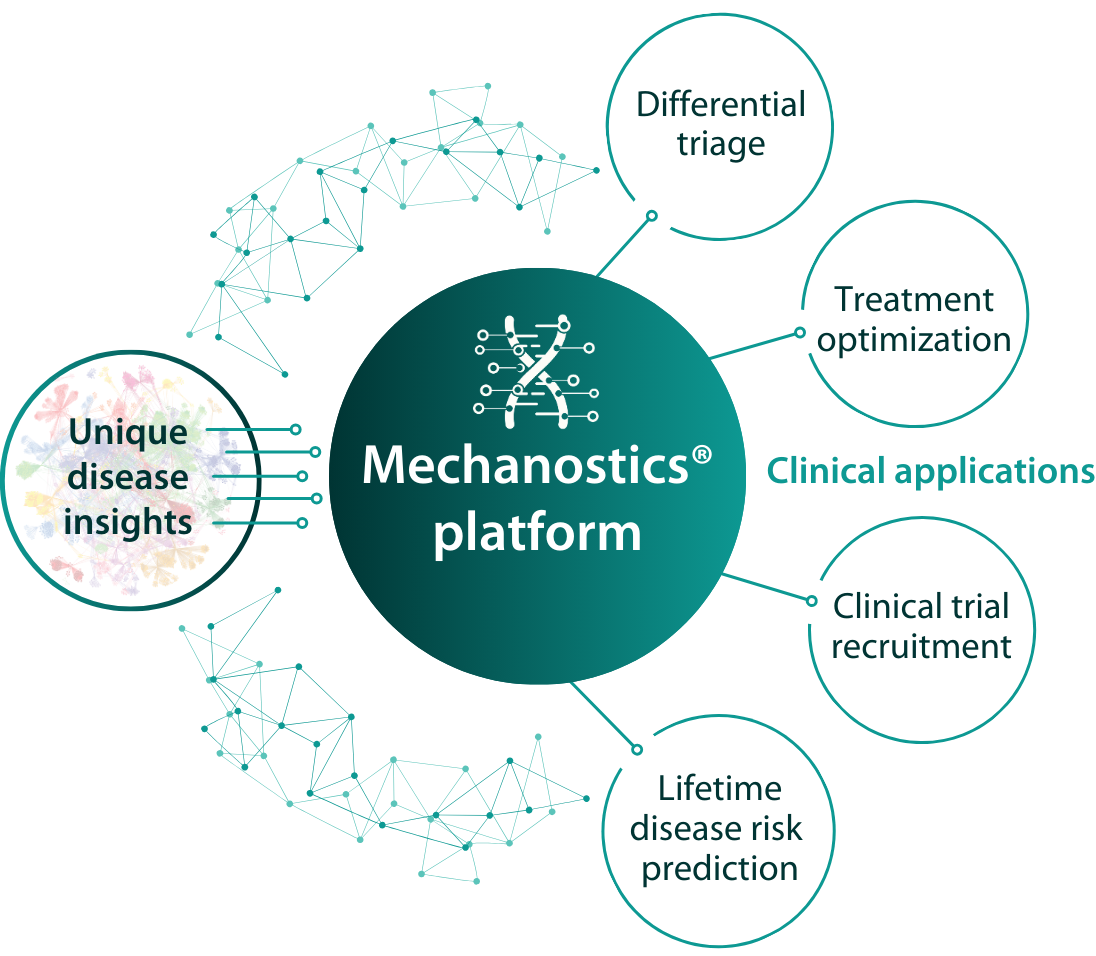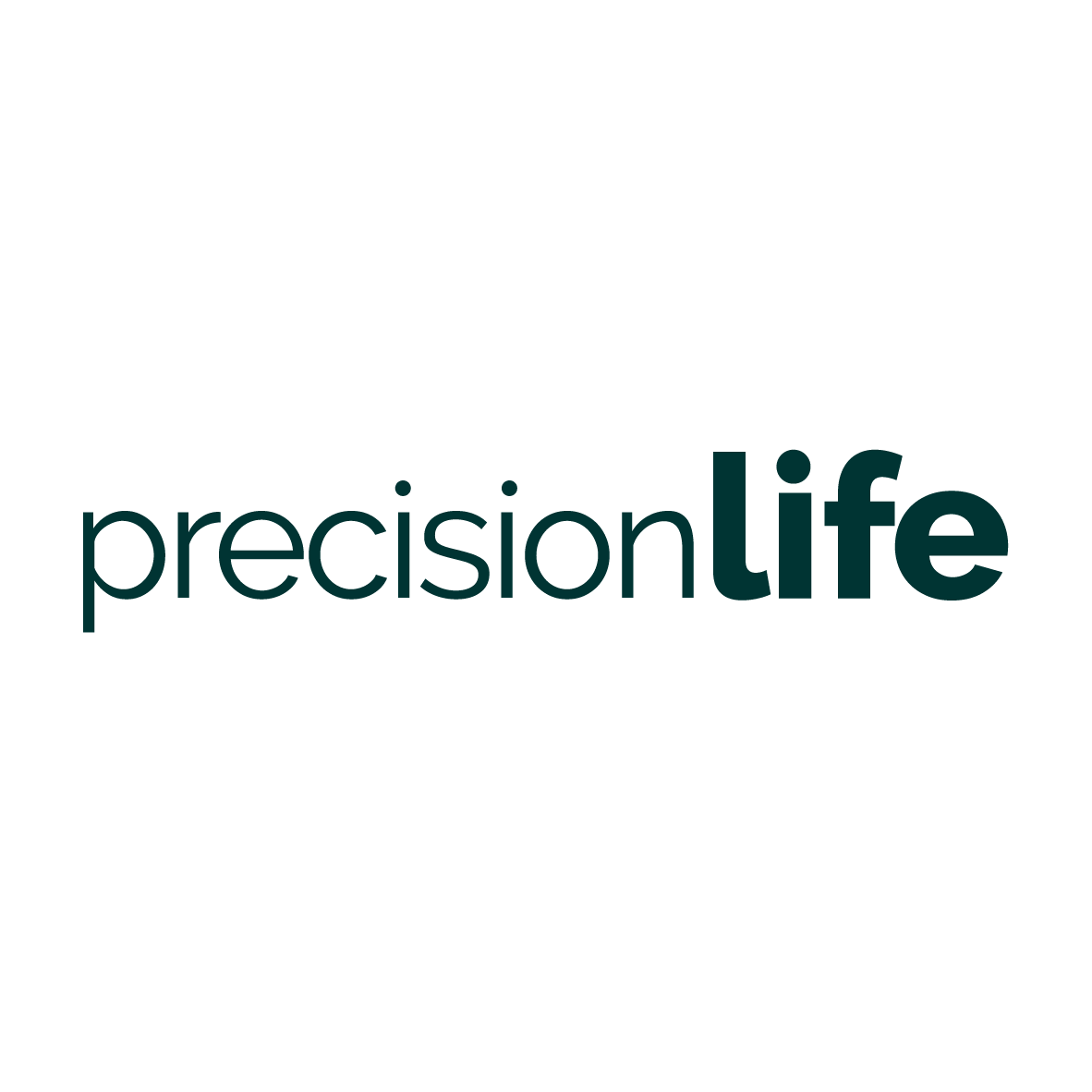Revealing the mechanisms of disease
Chronic diseases affect billions of people and are crippling healthcare systems around the world. They are deeply complex and many lack accurate diagnostics or effective treatments.
Mechanostics® open a new frontier in precision medicine – with unique actionable insights into over 60 complex diseases.
These are a new class of tests accelerating diagnosis, predicting & preventing chronic diseases, and recruiting patients likely to respond to specific medicine into clinical trials.
Identify the biological mechanisms causing & preventing disease
Predict each individual's lifetime risk of disease
Enable differential triage and faster diagnosis
Help identify optimal treatments for specific patients*
Detect earlier, intervene effectively and prevent disease
*For research and clinical trial use only.


Fast, low-cost, and non-invasive
Mechanostics have multiple advantages over polygenic and metabolomic diagnostics in complex conditions and power complementary new clinical applications.
They are rapid and non-invasive, using a simple cheek swab to reveal mechanism-based biomarkers associated with disease risk & resilience.
They can be deployed at-home as well as primary and secondary care and are compatible with widely available genotyping platforms used in CLIA/CAP labs around the world for easy and scalable delivery.
Predict and prevent chronic diseases that account for over 80% of all healthcare costs
Clinically actionable results
Mechanostic tests transform detection, treatment and prevention of complex diseases that affect over 5 billion lives.
Identifying a patient’s specific risk factors and disease mechanisms guides the development of personalized care pathways. These can include tailored monitoring, lifestyle changes and protective prophylactic therapies to delay onset and prevent progression of major chronic diseases.
This is precision medicine, for everyone.
Supporting a range of clinical applications and at-home tests
Differential Triage & Accelerated Diagnosis
Identifying key disease mechanisms to enable faster, more accurate referrals
Many chronic conditions have overlapping symptoms which often results in delayed referrals, clinical waste and incorrect diagnoses.
Mechanostics identify the underlying biological mechanisms driving disease in each patient, providing clear, actionable insights to accurately distinguish between conditions.
This enables differential triage across chronic diseases to more effectively manage non-specific referrals, so that patients can be allocated to the right specialty for the right procedures – preventing backlogs and disease progression in patients, reducing inappropriate specialist referrals and expensive confirmatory testing, and avoiding ineffective treatments.
For diagnostics
Diagnostics providers gain high-value tools that improve clinical efficiency, integrate seamlessly with existing genotyping platforms, and improve the delivery of care to patients.
For healthcare
Healthcare systems benefit from reduced diagnostic delays, fewer unnecessary investigations, and faster triage to the right care pathways where they can deliver procedures more efficiently - optimizing resource allocation to relieve pressure on specialist services and improve patient outcomes.
Treatment Optimization
Targeting treatments to the right patients
Mechanostics enable targeted decision-making by identifying the specific disease mechanisms active in each patient – stratifying patients by mechanism, and showing the therapy that is most likely to be effective for them.
These insights determine which patients are most likely to benefit from a given treatment – and potentially avoid adverse reactions, and tolerability issues.
This approach enables payers to prioritize the treatments that align with the patient’s underlying disease biology. For example, mechanostics tests can identify those patients most likely to benefit from GLP-1 receptor agonists.
For biopharma, CRO & diagnostics
Biopharmaceutical, CRO and diagnostics companies can develop and easily deploy our mechanostic tests as high-value companion diagnostics that support precision regulatory strategies, personalized treatment strategies and improve therapy ROI.
For payers
Healthcare payers may benefit from being able to identify patients who will not tolerate specific drugs, saving them from adverse events, lowering overall drug costs and giving better patient outcomes.
Clinical Trial Recruitment
Smarter recruitment for faster, more effective trials
Mechanostics transform trial recruitment by identifying patients with the specific genotypic and mechanistic profiles that are targeted by new investigational therapies - improving response rates and trial efficiency from the outset.
Our low-cost, non-invasive tests use saliva or buccal swabs and run on standard genotyping arrays compatible with CLIA/CAP-accredited labs worldwide.
This makes Mechanostic screening highly scalable, enabling rapid pre-screening of large patient registries and populations across diverse sites and geographies.
For clinical trial design & enrichment
Biotech and pharma partners can run smaller, faster, and more successful trials by enriching for the patients most likely to respond. Mechanostics reduce response heterogeneity, improve targeting of inclusion criteria, and support enriched trial design strategies.
By combining precision recruitment with global scalability, Mechanostics can lower drug development risk, accelerate timelines, and increase the probability of success – helping to bring precision therapies to market faster.
Disease Risk Prediction
Identifying at-risk patients before symptoms emerge
Mechanostics enable proactive healthcare by detecting subtle, highly predictive genotypic signatures long before clinical symptoms arise. Using combinatorial analytics, our tests identify individuals at elevated risk based on the specific biological mechanisms that drive disease.
The tests make large-scale population screening practical and cost-effective with low-cost test kits and compatibility with widely available genotyping arrays.
For diagnostics
Diagnostics providers can offer next-generation risk prediction tools in complex diseases affecting hundreds of millions of patients. Adding clinical value and creating new revenue streams.
For healthcare
Healthcare providers benefit from earlier interventions, reduced late-stage diagnoses, and the ability to shift from reactive treatment to preventative care – improving outcomes while lowering long-term costs.
Early Intervention & Prevention
Detecting risk and preventing disease with clinically actionable insights
Mechanostics determine an individual's lifetime risk of developing specific chronic diseases by identifying the genotypic signatures and biological mechanisms that drive (and prevent) disease onset.
This empowers clinicians to implement tailored early interventions - from lifestyle modifications and active monitoring to prophylactic therapies - to delay or even prevent disease progression.
PrecisionLife is uniquely positioned to go further, identifying actively protective biology (disease resilience mechanisms) that informs the development of next-generation prophylactic drugs and vaccines targeting major chronic conditions.
For diagnostics
Diagnostics providers can expand the value of routine testing into common chronic diseases by offering predictive tools that support prevention-focused care models and public health strategies.
For healthcare
Healthcare systems benefit from a measurable reduction in future disease burden, enabling more sustainable care delivery and longer, healthier lives for patients.
Major benefits for patients, payors & providers
Mechanostics benefits for providers:
1. Personalized, precision and preventative insights
Mechanostics identify disease mechanisms, helping establish the best care pathway for individual patients.
2. Clearer Clinical Decision-Making
Accelerates triage and diagnosis of overlapping symptom conditions, reducing time to treatment.
3. Practical in Routine Care
Delivered via non-invasive samples, usable in primary care or at home without specialist infrastructure.
4. Earlier, Better Outcomes
Enables proactive care by identifying risks before severe symptoms develop - saving clinician time and improving patient quality of life.

Mechanostics allow payers to:
1. Reduce Costs of Care
Early risk prediction and stratification lowers unnecessary treatments and hospitalizations, reducing spend.
2. Promote Health Equity
Common variant combinations improve predictive accuracy across diverse ancestries and populations.
3. Streamline Diagnosis
Low-cost, non-invasive testing supports efficient triage and reduces burden on healthcare systems.
4. Enable Reimbursement
Demonstrated precision in stratification supports long-term cost savings and payer adoption.

Mechanostics offer diagnostics providers:
1. Access to Major Unaddressed Markets
Mechanostics target underserved chronic conditions responsible for over 80% of healthcare costs - unlocking large new diagnostic markets.
2. Scalable Revenue Growth
High-prevalence conditions support recurring revenues via self-pay and licensing models across a global patient base.
3. Easy Lab Deployment
Tests use standard genotyping platforms already in CLIA labs worldwide - enabling rapid, low-cost global rollout.
4. Competitive Differentiation
Complement polygenic/metabolomic tests with disease-specific triage and mechanistic insight - creating real product advantage.

Mechanostics benefits for patients:
1. Faster, More Accurate Diagnosis
Uncovering the cause of symptoms, reducing diagnostic delays and misdiagnoses.
2. Personalized, Effective Treatments
Supporting clinical trial recruitment and selection of therapies that are more likely to work and less likely to cause harm.
3. Convenient and Non-Invasive
Tests can be taken at home or in a primary care setting – no hospital visits or invasive procedures required.
4. Proactive, Preventive Care
Identifying risk before disease develops to stay healthier, longer.
We are validating Mechanostic® tests for a range of diseases in clinical studies and will make them available for patient use once approved by the relevant health authorities.

Tab heading
Mechanostics benefits for providers:
1. Personalized, precision and preventative insights
Mechanostics identify disease mechanisms, helping establish the best care pathway for individual patients.
2. Clearer Clinical Decision-Making
Accelerates triage and diagnosis of overlapping symptom conditions, reducing time to treatment.
3. Practical in Routine Care
Delivered via non-invasive samples, usable in primary care or at home without specialist infrastructure.
4. Earlier, Better Outcomes
Enables proactive care by identifying risks before severe symptoms develop - saving clinician time and improving patient quality of life.

Mechanostics allow payers to:
1. Reduce Costs of Care
Early risk prediction and stratification lowers unnecessary treatments and hospitalizations, reducing spend.
2. Promote Health Equity
Common variant combinations improve predictive accuracy across diverse ancestries and populations.
3. Streamline Diagnosis
Low-cost, non-invasive testing supports efficient triage and reduces burden on healthcare systems.
4. Enable Reimbursement
Demonstrated precision in stratification supports long-term cost savings and payer adoption.

Mechanostics offer diagnostics providers:
1. Access to Major Unaddressed Markets
Mechanostics target underserved chronic conditions responsible for over 80% of healthcare costs - unlocking large new diagnostic markets.
2. Scalable Revenue Growth
High-prevalence conditions support recurring revenues via self-pay and licensing models across a global patient base.
3. Easy Lab Deployment
Tests use standard genotyping platforms already in CLIA labs worldwide - enabling rapid, low-cost global rollout.
4. Competitive Differentiation
Complement polygenic/metabolomic tests with disease-specific triage and mechanistic insight - creating real product advantage.
How Mechanostics compare with traditional diagnostics
| Mechanostics | Diagnostics | ||
|---|---|---|---|
| Test | Genotype | Metabolomic/genetic | |
| Sample type | Buccal swab (non-invasive) | Various (non-invasive – surgery) | |
| Cost per test | $ | $ – $$$ | |
| Administration | Self-test / Point of care | Point of care / Surgical | |
| Readout | Disease risk and protective effects. Mechanisms underpinning disease. | Active disease status. [Surrogate] of disease progression. | |
| Patient insights | Most likely effective treatment. Expected symptoms / clinical presentation. Likely disease trajectory (pre-symptomatic). | [Surrogate] marker, may be linked to clinical endpoint. [Stage of disease, progression rate]. | |
| Applications | Differential triage between similar conditions. Therapy selection by disease + mechanism. Clinical trial design & recruitment biomarkers. Early (pre-symptomatic) detection of disease risk for personal preventative health. | Confirmation of disease after presentation of clinical symptoms. Early pre-symptom screening. Measurement of residual disease. [Therapy selection by disease]. |
A simple test
Non-invasive sample taken at home or in a primary care setting, tested against a standard genotyping array
Rapid results
Results delivered by our clinical decision support platform, translating disease mechanisms into actionable insights
Predicting risk
Pre-symptomatic risk detection allowing for proactive monitoring, lifestyle changes, or therapeutic interventions
Detecting cause
Identifying the underlying biology driving disease, enabling personalized care based on each patient’s specific mechanisms
"This unrivaled understanding of the mechanistic causes of disease enables us to better determine disease risk, accelerate diagnosis, and guide more effective treatment strategies and care pathways to improve lives."
Amy Rochlin
Chief Executive Officer
Complex Disorders Alliance
Let's talk
Patients are counting on us
We're always looking for new partners to achieve better health for patients, faster.
Contact us to request more information or discuss a collaboration.


